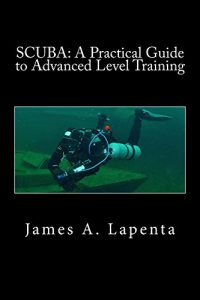Building on his first book, "SCUBA: A Practical Guide for the New Diver", James Lapenta addresses what is most often the next step in diver training. Advanced Level or Advanced Open Water training is often taken by divers to gain additional skills and knowledge. It is also taken to allow them to gain access to more challenging dives and dive sites. These also pose a greater degree of risk to the individual.
Unfortunately some advanced classes are no more than a "taste" or "tour" of advanced level dives. The divers do not get the new knowledge and skills required to safely embark on these dives. In order to safely pursue these dives James has outlined the steps to take to reduce the risk of injury and worse. From describing the dives to offering advice on the content one should expect, as well as selecting an instructor, he offers new and not so new divers guidance. Additional sections on equipment options, air supply management, dive planning, and dive selection for maximum learning potential are looked at.
Also included is a section on a subject often overlooked in recreational SCUBA diving - the after-effects of a diving accident and rescue/recovery on the rescuer and witnesses to the event. Post Traumatic Stress in Recreational Dive Rescues is a real possibility and one that must be looked at when executing dives with greater risk. Safety in training and after training is the heart of this work and the driving force behind its publication. James has experienced the best in training and that which left something to be desired. He gives examples of both throughout the work.
If you do not have his first book, it is highly recommended that you also acquire it as a companion to this one. While they do contain some sections of the same information, there are sections in the first book that are not included in this that are highly beneficial.
Unfortunately some advanced classes are no more than a "taste" or "tour" of advanced level dives. The divers do not get the new knowledge and skills required to safely embark on these dives. In order to safely pursue these dives James has outlined the steps to take to reduce the risk of injury and worse. From describing the dives to offering advice on the content one should expect, as well as selecting an instructor, he offers new and not so new divers guidance. Additional sections on equipment options, air supply management, dive planning, and dive selection for maximum learning potential are looked at.
Also included is a section on a subject often overlooked in recreational SCUBA diving - the after-effects of a diving accident and rescue/recovery on the rescuer and witnesses to the event. Post Traumatic Stress in Recreational Dive Rescues is a real possibility and one that must be looked at when executing dives with greater risk. Safety in training and after training is the heart of this work and the driving force behind its publication. James has experienced the best in training and that which left something to be desired. He gives examples of both throughout the work.
If you do not have his first book, it is highly recommended that you also acquire it as a companion to this one. While they do contain some sections of the same information, there are sections in the first book that are not included in this that are highly beneficial.






